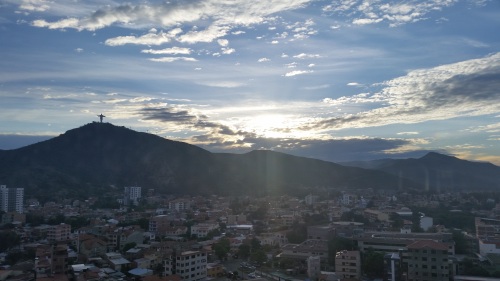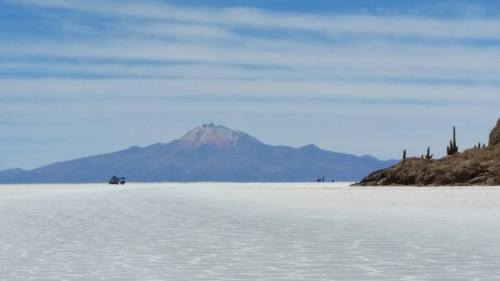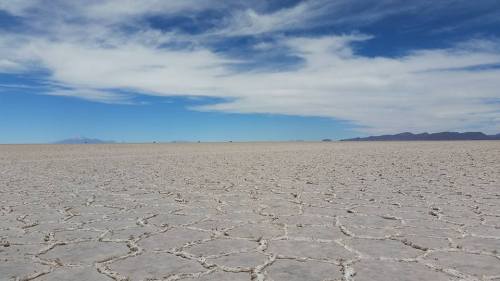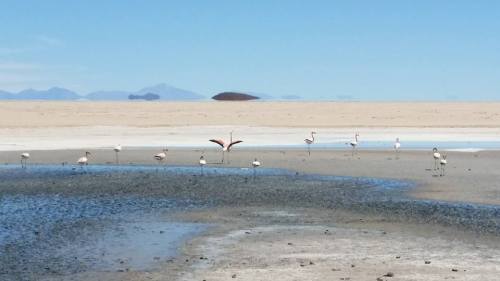This post was in the back of my head right after I returned from Bolivia and remained there for 2 years. A friend who asked me for some travel tips before her trip there inspired me to get this onto the screen and onto the internets, so thank you – you know who you are 🙂
1. Bolivia is far.
It doesn’t seem like it on the map, and the 1-hour time zone difference furthers the illusion. But if you are flying from most anywhere in the US to most anywhere in Bolivia, you will need to somehow get to Miami and then take a night flight from there to La Paz or Santa Cruz. Any other destinations, including Uyuni, will require a stop-over in either of those two cities, so be prepared for travel time from 12 to 20 hours, with a nice long layover in Miami. (Oh, and flying on the state airline BoA is like a trip back in time. The aircraft are old but the flight crew friendly.)
2. Bolivia is high up. Like really high up.
When I first traveled to Denver for work, the staff at the Denver office kept me under close watch as they were concerned about my health in the mile-high city. But they didn’t realize I’d spent over 2 weeks in Bolivia, starting from Cochabamba (in a valley, thus only at 8000 something feet) and continuing through Salar de Uyuni (12 000 feet), compared to Denver’s measly 5000.
The airport in La Paz is actually in El Alto (‘The Tall One’) on a ridge overlooking the city.

Landing in El Alto
3. Altitude sickness is a thing (4, 5, and 6 are related).
But by no means as fearsome as it sounds. I came to the country more or less unprepared and was fine, drinking water and eating lots (of carbs, mostly). A few days into my stay we prepared to ascend the hill overlooking Cochabamba to see the Christ statue towering over the city

Cristo de la Concordia and a Cochabamba sunrise
and it was then that a wave of nausea and fatigue hit me.

It is purported to be the tallest Christ statue in Latin America (surprisingly less famous than the Rio one!)
A quick foray into a pharmacy with a local resulted in the coveted “sorojchi pill” (soroche is the word for altitude sickness). It was just a piece of foil with a few tablets, no instructions or side effects, so you might prefer to arm yourself with something verifiable before leaving the US (the internet now tells me what I took was just aspirin with no preventative features, so yes, maybe Diamox – Acetylzolamide – is what you really want).
4. Drink. Mostly bottled water, if you’re sensible.
Especially in the salt flat of Uyuni, I found myself constantly thirsty. And please, especially if you are suffering from altitude sickness, stick to bottled water.

A group of Russian tourists in our hotel were quite liberal in ordering alcoholic drinks one night – the next morning an ambulance was outside our hotel with two of them being carted out (and I’m pretty sure it wasn’t the girl who impaled herself on my knife when she shoved her way into the buffet line before me.) (She didn’t actually impale herself, but yes she did jump the line and bump into my plate and utensils and then set on me in Russian. I only half-understood).
Anyway, alcohol + high altitudes = no bueno.
Oh, if you want something interesting and exotic to drink, try mate de coca (tea from coca leaves). It’s the local antidote for altitude sickness. I’m not sure if it really works, but it’s tasty and you can’t really get it outside of South America (and you shouldn’t try, as apparently it is illegal in the US).
5. Be prepared to be sleepy.
Every time we got into our car on the salt flats, I fell asleep.

And it wasn’t the endless horizon or our tour guide’s fault.
I just could not keep my eyes open if I wasn’t in the fresh air. My husband has many fond memories of listening to our tour guide/driver explain fascinating tidbits of local history while I snore and drool onto his shoulder (love you!).
6. Everything is dry. Very dry.
Even though we went during the ‘wet season’, it never rained on the Salar. Everything was dry and towards the end of the day you’d feel a salt-encrusted mask on your face. I’d suggest bringing numerous lip balms and some hand and face moisturizer. Especially if you sleep in a salt hotel, where you will be surrounded, you know, by salt.
Speaking of moisturizers, use sunscreen and bring your sunglasses!! Being in Uyuni is like being on a frying pan. Even including the salt for seasoning 🙂

Here is a cactus and some dry earth to prove my point.
7. Uyuni itself is nothing to write home about.
I obviously mean the town, not the salt flats. Stay at a salt hotel away from the town if you can – the town is nothing more than a few dreary streets full of tour operator offices and quinoa-selling shops. And a hostel and saloon or two. Maybe there aren’t actually any saloons there. But it seems like there should be.
8. Quinoa soup is amazing, and Bolivia has lots of potatoes.
Probably one of the simplest and best meals of my life was a quinoa broth we had on the Salar.
Bolivians love their potatoes and you may be surprised to find that your meal contains 3 different kinds of potatoes (the first time I had Chuño, a freeze-dried potato, I was convinced it was a mushroom due to its umami taste). Remember, carbs help with the altitude sickness!
9. Think about when you are visiting, and don’t skimp on quality.
I had read a number of terrifying stories about the awful tours that happen between Christmas and New Years, when alcohol is plentiful and sober drivers are not. It seems hard to imagine two cars colliding on such a vast flat surface but unfortunately many of these stories are true.

There are roads in the Salar….

But mostly this is just one big road. No traffic jams.
Still, we went there at this most dangerous time of year and were completely fine. So, as in anything, do your research and only work with a reputable company.
And, private tours are probably the way to go. You will have a good driver, a safe car with seatbelts, nice hotels to stay at, and the freedom to customize your itinerary along the way. Our guide threw in a star-viewing session at night on the cold and silent salt flat, an experience I will never forget!
10. Speaking Spanish helps.
Even knowing the basics will help you get by. Our driver was actually a native to the area and Spanish wasn’t his first language either, but he appreciated all the efforts we made (rather, my husband made, as I spent my time busily napping) to speak in Spanish.
11. Have fun!
Bolivia is a country of mostly undiscovered natural charm, delicious and hearty food, a strong indigenous culture and sense of tradition, and friendly and fun people.
You’ll enjoy your time there. Who wouldn’t?


